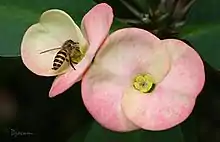Apis cerana indica
Apis cerana indica, the Indian honey bee, is a subspecies of Asiatic honey bee. It is one of the predominant bees found and domesticated in India, Pakistan, Nepal, Myanmar, Bangladesh, Sri Lanka, Thailand and mainland Asia. Relatively non-aggressive and rarely exhibiting swarming behavior, it is ideal for beekeeping.
| Apis cerana indica | |
|---|---|
 | |
| Scientific classification | |
| Domain: | Eukaryota |
| Kingdom: | Animalia |
| Phylum: | Arthropoda |
| Class: | Insecta |
| Order: | Hymenoptera |
| Family: | Apidae |
| Genus: | Apis |
| Species: | |
| Subspecies: | A. c. indica |
| Trinomial name | |
| Apis cerana indica (Fabricius, 1798) | |
It is similar to the European honeybee (Apis mellifera), which tends to be slightly larger and can be easily distinguished.
They usually build multiple combed nests in tree hollows and man-made structures. These bees can adapt to living in purpose-made hives and cavities. Their nesting habit means that they can potentially colonize temperate or mountain areas with prolonged winters or cold temperatures. Colonies contain only a few thousand workers, compared to the 50,000 typical of European honey bees.
It is one of the important pollinators for coconut palms; the other species are Apis florea, Apis dorsata and Apis mellifera (the European bee).[1]
A recent paper describing the discovery of Apis karinjodian, a species of cavity-nesting honeybee endemic to the Western Ghats region of India, also proposes that A. Indica is a distinct species from A. Cerana, and that its homeland of Southern India may also be the center of origin for the European honeybee, Apis mellifera.[2][3]
References
- P.K. Thampan. 1981. Handbook on Coconut Palm. Oxford & IBH Publishing Co.
- Shanas, S.; Anju, Krishnan G.; Mashhoor, K. (2022-09-30). "Identity of cavity nesting honey bees of the Indian subcontinent with description of a new species (Hymenoptera: Apidae: Apinae: Apini: Apis)". Entomon. 47 (3): 197–220. doi:10.33307/entomon.v47i3.755. ISSN 0377-9335. S2CID 253393003.
- Bureau, The Hindu (2022-11-04). "New honeybee species, endemic to Western Ghats, found". The Hindu. ISSN 0971-751X. Retrieved 2022-11-05.
- Benjamin P. Oldroyd and Siriwat Wongsiri. Asian Honey Bees (Biology, Conservation, and Human Interactions). 2006: Harvard University Press, Cambridge, Massachusetts and London, England.
- Tautz, J and M. Lindauer. 1997. "Honeybees establish specific nest sites on the comb for their waggle dances". Journal of Comparative Physiology 180:537-539.